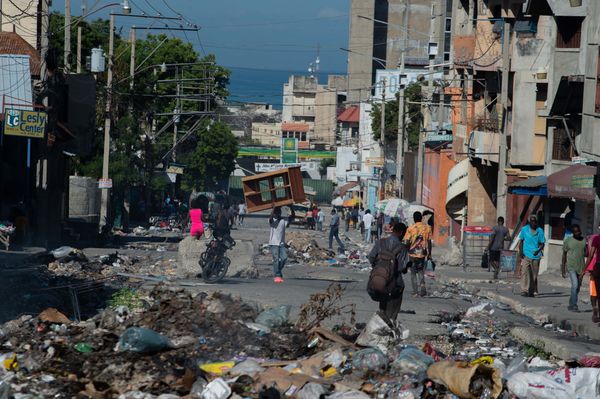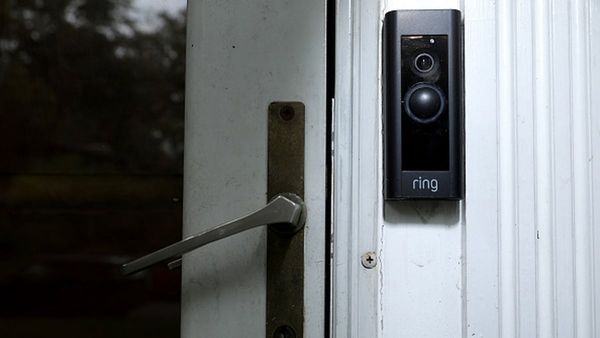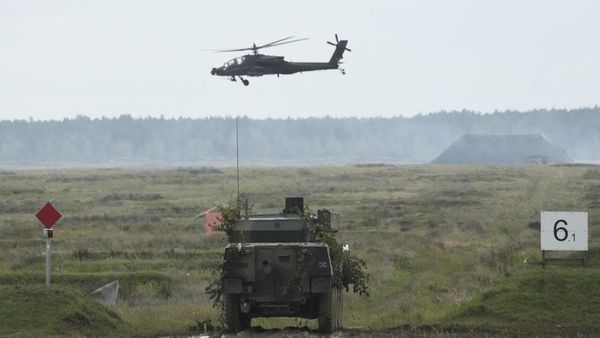
Straight and bare, Hatt Road runs south-west from Mparntwe-Alice Springs before it suddenly swings north through a narrow gap in the MacDonnell Ranges.
It is what lies beyond that draws protesters here time and time again.
Hatt Road – unremarkable save for the fierce signs insisting “No Photography From This Point On” and demanding drivers “Turn Around Now” – is the main route into Pine Gap, the highly secretive joint Australian-US satellite communications and signals intelligence surveillance base.
Twenty hectares and heavily guarded, “the base” – as it’s known locally – sits in a secluded, narrow valley, flanked by the sparse hills of the ranges. Little is officially confirmed about its operations but through leaked documents and whistleblower disclosures its criticality to US global-intelligence gathering is uncontested.
Ostensibly, the “joint defence facility” established by the CIA in 1966 is controlled by both Australia and the US. But Pine Gap has been described as America’s most valuable intelligence site outside US soil.
On 9 October two activists from Mparntwe for Falastin locked themselves to a concrete-filled barrel, blocking Hatt Road for nine hours and preventing Pine Gap workers from accessing the base. Flanking their protest were two boats, representing the aid flotilla then approaching the occupied territory of Gaza from the Mediterranean.
The action, one protester, Jorgen Doyle, argued, was legally justified because it prevented Pine Gap workers from taking part in the commission of genocide on the other side of the world.
“We’re here because Pine Gap is sharing surveillance data, including geolocation information from mobile phones, with the genocidal Israeli regime, who are targeting journalists and their families, children, teachers, doctors, patients and the entire population of Palestine,” Doyle claimed.
He tells Guardian Australia: “Pine Gap looms large in the national imagination, but people are not aware of the violence that the base perpetrates internationally: we want more people to understand Australia’s role in the commission of genocide.”
A rising resistance to Pine Gap
A UN commission of inquiry reported last month that the Israeli government and military had committed genocide in Gaza: Israeli leaders had evinced “direct evidence of genocidal intent”, the commission found, and were responsible for military operations that killed unprecedented numbers of civilians and sought to “destroy the Palestinians in Gaza”.
In response, Israel’s foreign ministry issued a statement saying it “categorically rejects this distorted and false report and calls for the immediate abolition of this commission of inquiry”.
But the 9 October protest over Australia’s claimed complicity in international crimes was only the latest in a re-emergent campaign seeking not simply to disrupt defence workers and contractors accessing Pine Gap but to contest the base’s presence on Australian soil.
The Arrernte people – on whose country Pine Gap was imposed without consultation – never ceded their land for the base. They have remained implacably opposed to its existence, an antagonism brought into further relief by the conflict in Gaza.
“Who gave America the right to put their military base on our sacred land and use our country to kill innocent women, men, children and old people overseas?” an Arrernte elder, Felicity Hayes, told a protest last year. “We are so sorry this is happening, this shouldn’t be happening, we support the people of Palestine.”
Over decades, opposition to Pine Gap’s presence on Australian soil has ebbed and flowed, demonstrators say. The 1980s were a peak, before more muted disquiet during the “war on terror” dominated early years of this century.
Sign up: AU Breaking News email
But resistance, they say, is flourishing again.
Since 4 July – US Independence Day – protesters have gathered each fortnight near the gates of the base, bearing placards and banners. Miniature replica radomes are ceremonially destroyed at the end of the protest.
“US global hegemony is on the wane,” Doyle says. “The opposition in central Australia to the base is stronger than it has been in a long time … and scepticism about the US alliance has never been so mainstream.”
In September, after nearly two years before the Northern Territory’s courts, Carmen Escobar Robinson and Tommy Walker were found guilty of “failing to cease to loiter” (charges of obstructing a public road and causing a traffic hazard were dropped) over a 2023 protest that blocked Hatt Road. The pair received no conviction but had a good behaviour bond and a $150 victims’ levy imposed.
In the wake of the court’s judgment, Robinson says that – beyond blocking workers’ access to Pine Gap – the protest sought to draw attention to Australia’s involvement in military strikes and potential international crimes.
“With no transparency to parliament or the public, Australia is hardwired into the US military surveillance industrial complex through Pine Gap. The Australian public should be very concerned… how many countries are we unofficially attacking? How many people is Pine Gap involved in killing in Palestine? Lebanon? Syria? Yemen? Iran?”
‘War crimes’ on Arrernte country
Dr Richard Tanter, an honorary professor of international relations at the University of Melbourne and a senior research associate at the Nautilus Institute for Security and Sustainability, was called as an expert witness in Robinson’s case. He detailed to the court Pine Gap’s direct role in providing intelligence to the Israel Defense Forces via the US National Security Agency.
Tanter said one of Pine Gap’s key functions was as a ground station, control centre and principal downlink for US “Advanced Orion” signal intelligence satellites – in geosynchronous orbit high above the equator – three out of four of which continuously surveil a broad swathe of the Earth that includes Gaza.
These satellites are able to monitor a wide range of electronic signals, including military emissions such as missile telemetry and radar, but also civilian communications like radio communications and mobile phone transmissions.
In an interview, Tanter says: “Pine Gap is a critical part of surveillance for operations which supplies intelligence to the United States and, we now know, to Israel. Palestinian civilians are part of their surveillance targeting maps.
“We know from the historical record that data downlinked through Pine Gap, and in some cases processed through Pine Gap, is passed on to the National Security Agency in Maryland, and we know that is passed on to IDF.”
Australian assistance in providing information to Israel stretches back to the Yom Kippur war in 1973, when the US supplied the IDF with Pine Gap-derived intelligence on Egyptian military forces’ positions in the Sinai: information that was critical to the war’s outcome and that was passed on without Australian concurrence.
“And documents leaked by [whistleblower] Edward Snowden revealed the construction of an extraordinarily dense and comprehensive network of agreements between US signals intelligence authorities and IDF signals intelligence units. These documents – which are not disputed – show the general trend, which is for Israel to have access to American NSA data collected globally … and to be provided that information largely without condition.
“It is highly probable that Pine Gap data has been provided to the IDF after October 8 [2023] and is still provided today.”
While a series of objections were made in the court hearing to restrict the breadth of Tanter’s testimony, his evidence was neither contested nor contradicted.
In the Northern Territory local court, Judge John McBride ultimately excluded Tanter’s evidence as irrelevant to the offence before him. The judge ruled that for Robinson and Walker’s actions to be justified, they needed to demonstrate “an application of force” in preventing a crime, which their protest had not done.
John Lawrence SC, acting for Robinson and Walker, argued that the protest’s rationale was to stop the commission of genocide – an international crime – on the other side of the world.
“One of several defences to an offence in Australian law is the prevention of the commission of another offence, and that’s precisely what they did by blocking access to Pine Gap for six hours and for 100 personnel: they were stepping in to stop the ‘crime of crimes’, genocide.”
But the judge did not agree, finding: “The conduct of both defendants, deliberate as it was, cannot be accepted by this court as reasonable in justifying their intended commission of a criminal offence.”
Asked in Senate estimates this month if Pine Gap provided surveillance data or signals intelligence that assisted Israeli strikes on Gaza’s al-Shifa hospital or the Nuseirat refugee camp, the director general of the Australian Signals Directorate, Abigail Bradshaw, said: “Consistent with the practice of successive governments, we do not comment on the operational activities of Pine Gap.”
Following this month’s protest (Doyle and a fellow protester have been charged with “fail to cease to loiter” and will face court next month), NT police southern commander James Gray-Spence said police respected the right to protest.
“However, we do not support protest activities involving [alleged] unlawful conduct including intentionally obstructing public roads that deprives the Alice Springs community of multiple police and fire crews who should be combatting domestic violence, property crime and other emergencies.”
The pair will face court on 13 November.
A fragile ceasefire holds – just – in Gaza. There is violence still (more than 100 Palestinians have died since it was brokered) and access to healthcare and aid remains limited. Doyle is resolute in defending his protest.
“The biggest crimes being committed on Arrernte country right now are the war crimes that the Pine Gap base is participating in.”
The best public interest journalism relies on first-hand accounts from people in the know.
If you have something to share on this subject, you can contact us confidentially using the following methods.
Secure Messaging in the Guardian app
The Guardian app has a tool to send tips about stories. Messages are end to end encrypted and concealed within the routine activity that every Guardian mobile app performs. This prevents an observer from knowing that you are communicating with us at all, let alone what is being said.
If you don't already have the Guardian app, download it (iOS/Android) and go to the menu. Select ‘Secure Messaging’.
SecureDrop, instant messengers, email, telephone and post
If you can safely use the Tor network without being observed or monitored, you can send messages and documents to the Guardian via our SecureDrop platform.
Finally, our guide at theguardian.com/tips lists several ways to contact us securely, and discusses the pros and cons of each.







